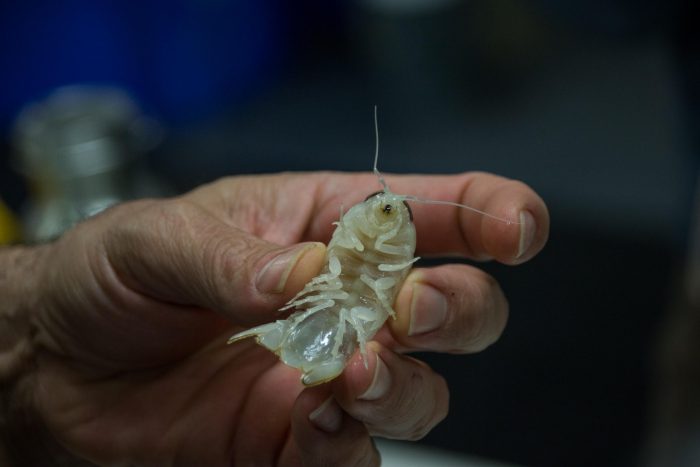*This article was updated Feb. 13 to reflect a change in the Jocelyn Bell Burnell lecture from Feb. 13 to Feb. 14 due to the weather.
By Daniel Dunaief
And the winner is … women in science!
While Stony Brook University’s Institute for Advanced Computational Science (IACS) announced the winners of its inaugural challenge to celebrate the scientific and engineering achievement of women on Feb. 7, the organizers and participants feel like they’ve already come out ahead.
The inaugural competition, which 195 students kindergarten through 12th grade in schools on Long Island entered by submitting a one-minute video, included prizes for the 13 finalists. The winner received $1,000 prize, the runner up got $750 and the third-place finisher collected $500.

“The goal of it was to celebrate the International Day of Women and Girls in Science, while simultaneously promoting the important role that women had in science in the last century,” explained Marivi Fernández-Serra, Professor in the Physics and Astronomy Department and at the Institute for Advanced Computational Science.
In their videos, the students selected one of nine scientists that included experiments showcasing the work of these researchers by using computers or household products to demonstrate the search for dark matter, explore the laws of conservation, create homemade telescopes, simulate a volcano with lava and many more.
Fernández-Serra, who had helped with a similar effort at the Institute for Theoretical Physics in Madrid, Spain, brought the idea for the competition to Mónica Bugallo, Professor of Electrical and Computer Engineering, Vice Provost for Faculty Affairs and Diversity, Equity and Inclusion and affiliated member of the IACS Faculty Director of the Women in Science and Engineering Honors Program, who immediately supported it.
Fernández-Serra thought the competition might attract 10 entrants in its inaugural year while Bugallo, who reached out to Long Island schools to showcase the competition, was confident local students would embrace the opportunity.
“Wait for a tsunami of participants,” Bugallo said she told Fernández-Serra, with whom she’s been a colleague and friend for years. “I was not surprised” by the contributions from the 103 teams, which included entrants from individual students and groups of as many as three students.
Bugallo, who recommended computer scientists Grace Hopper and mathematician and writer Ada Lovelace as important scientists for the competition, was impressed with the student effort.
“It was extremely tough to come up with the finalists,” said Bugallo.
Stony Brook plans to share the videos from the finalists after naming the winners.
Figure skating and conservation
One of the finalists, Katie Engel, a senior at Cold Spring Harbor High School, chose to demonstrate the work of Emmy Noether.
A German mathematician, Noether contributed to theoretical physics and abstract algebra. A theorem named after her, the Noether Theorem, explains that any continuous symmetry in a system has an associated conservation law. That helps explain how the speed of someone spinning in a chair changes depending on how far their arms re-extended.

An ice skater since she was six who is also interested in studying computer science or engineering, Engel had never heard of Noether but was intrigued with the physics and with the person who helped discover ways to characterize it.
In her entry, Engel explained the mathematical principals on a white board and then recorded a video of herself spinning on ice. When she learned about Noether’s life, Engel discovered that Noether was an important contributor to her field, despite some resistance to her work from men. “Reading about her stories is really inspiring,” said Engel.
Engel is stunned at the conclusions Noether reached with the tools at her disposal.
Currently working as an intern for Peter Koo at Cold Spring Harbor Laboratory, Engel suggested she is committed to pursuing her interest in science, technology, engineering and math fields during and after college.
Engel was also a member of the robotics team at Cold Spring Harbor High School that won the regional conference and went to the World Championships in Houston last year. In robotics, Engel said the number of girls on the team declined from 10th through 12th grades.
She is, however, heartened to learn that 180 boys and 200 girls attended a recent research fair at her school.
New teaching tools
Fernández-Serra and Bugallo are hoping that teachers at all levels can use the videos to inspire students and help them connect with scientists whose contributions continue to resonate with current researchers. The purpose of activities like the competition is to “spark interest, so students want to investigate more,” said Bugallo.
Stony Brook plans to build on this experience in future years through either similar efforts or ongoing programs or initiatives. “Our intent was to have these challenges year after year if this was successful, and it obviously was,” said Bugallo.
In the immediate future, Fernández-Serra encourages students in the area to attend the upcoming talks given by University of Oxford astrophysicist Jocelyn Bell Burnell, who discovered the pulsar, as a part of the Della Pietra lecture series at the Simons Center for Geometry and Physics on Stony Brook University’s West Campus from February 13 through Feb. 15.
Bell Burnell is giving a general public lecture on Feb. 14 at 5 p.m., with a reception at 4:15 p.m. in the Simons Center Lobby. The lecture will also be livestreamed at scgp.stonybrook.edu/live.
Bell Burnell will also offer a special talk for high school students titled You Are Made of Star Stuff! on Feb. 15 at 11 a.m. that examines how and where elements in the human body were created in the cosmos. Both lectures will be held in the Della Pietra Family Auditorium (room 103).
A curiosity outside the classroom
For scientists, what they learn and study often stays with them long after they finish an assignment or submit or publish a paper.
Fernández-Serra, who studies the fundamental properties of liquid water using quantum mechanical simulations, thinks about how amazing water atoms are that are holding her when she swims.
As for Engel, thoughts of Noether will stay with her when she figure skates. “I probably can’t do a spin without thinking about her,” she said.
Heroes with staying power
For Fernández-Serra, Mildred Dresselhaus, one of the celebrated scientists of the past who was a part of the contest, was a “number one hero” in condensed matter physics.
Called the “Queen of Carbon,” Dresselhaus earned numerous awards, including the Presidential Medal of Freedom and the National Medal of Science and Engineering.
“She was a positive and brilliant scientist who never lost her enthusiasm and curiosity,” Fernández-Serra explained.
Stony Brook’s IACS team hopes this competition, the Bell Burnell lecture, and other efforts ignite such enthusiasm in the next generation of STEM students.






















